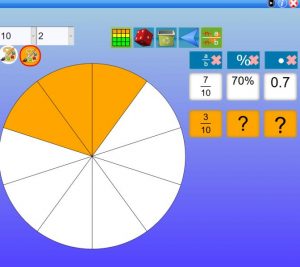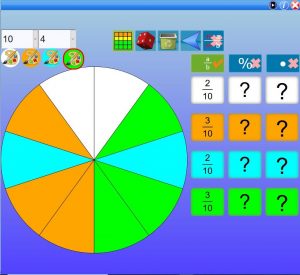As a learning support specialist teacher, my intermediate students struggle with many mathematical concepts. My students currently are struggling with understanding the relationships between fractions, percents and decimals. Fractions are introduced in the younger grades but as they move onto the next grade without the key foundational skills, the gap increasingly grows. I use many hands on manipulatives and last year discovered a free online interactive tool (visnos.com). I had hoped to use this interactive tool more, but didn’t have time to properly integrate in within my teaching practice as I was trying other methods and intervention programs. Thinking about the T-GEM approach, using this interactive math resource will fit well within my current unit. Using interactive manipulatives are helpful for struggling learners as it allows these students to work at their own pace and activities can be adapted to the individual learner. Further using technology allows for an engaging and interactive learning experience for my students. It’s also important for student to be able to connect curriculum to real life scenarios, and technology allows students to make these connections.
G-Generate:
Exploration is key for students. This will allow students to ask questions they may have, and connect previous knowledge with knowledge they are gaining through self-discovery. Students will be able to practice the relationships between fractions, percents and decimals. Students will also be able to practice and explore the relationship between equivalent fractions and develop strategies for converting fractions to decimals.
Students will use “Starter Calculate Percent Fraction Decimal” and “Percentage Fraction Decimal Grid” interactive activity to explore.


With students, go over key terminology and foundational concepts.
What are fractions?
What is the numerator and what is the denominator?
What are the various ways to represent fractions?
Where do we use and see fractions, decimals and percentages in our everyday lives?
Students will generate a hypothesis regarding the relationships between fractions, variables and decimals.
E-Evaluate:
During this stage, the teacher can pose questions that may not follow students’ hypotheses as this will allow students to evaluate the relationship. Teacher will also use equivalent fractions and have students determine the fractions, percentages and decimals. Here, students will have to use their numeracy skills to solve these questions.

M-Modify:
Teachers will ask students to represent fractions in lowest terms. Here students will have to use their multiplication and division skills to determine this relationship and apply their knowledge. How will students use their foundational knowledge and apply it to this activity.


Questions for students:
Can all fractions be reduced to lowest terms? What are the main “benchmark” fractions?
Can one fraction have many equivalent fractions? How can you show this visually and numerically?
How does multiplication and division relate to fractions, decimals and percent?
Khan, S. (2010). New pedagogies for teaching with computer simulations. Journal of Science Education and Technology, 20(3), 215-232.
Hi Amanda,
Thank you for your post! I too have many intermediate students who do not have a strong foundation of fraction work and therefor struggle to understand the relationships between fractions, decimals and percentages. I like how you thought to ask the students questions that didn’t follow along with their hypothesis, as this gets them to think from an alternate perspective. I think that the questions you came up with in the modify stage would be great to get the students to think more deeply about the relationships between fractions, decimals and percentages. After reading several posts on T-GEM, I explored the PhET simulations and there are several fraction related simulations on that website as well. It’s definitely worth a look: https://phet.colorado.edu/en/simulations/category/by-level/middle-school
Kathryn
Hi Kathryn,
I did use PhET simulations for another unit Area and Perimeter as my grade 5 students were having a hard time! It definitely helped them and was very interactive. I will definitely take a closer look at the fraction relation simulations. Thank you for sharing!
Hi Amanada
I really resonated with your statement “My students currently are struggling with understanding the relationships between fractions, percents and decimals. Fractions are introduced in the younger grades but as they move onto the next grade without the key foundational skills, the gap increasingly grows.”. It touches on the central reason why we are doing all of this… for our students. One of the central ideas of GEM is that students are generating multiple hypothesis, working with multiple patterns, and working with the teacher to determine misconceptions. I believe that this format really brings to light the thinking process of students and gives them the opportunity to in a non-linear way. As they connect new information to old information the hope is that more students will have those ah ha moments, and we can close the gap for many of our students.
Great post!
Hi Shayla,
Thank you for your comments. I find it so difficult to “close the gap” and find it always come down to time and not having enough of it! Do you find this in your school and class? On our caseload, we have so many students who struggle with math, yet cannot accommodate everyone. The real struggle is our intermediate students require a lot of support, leaving minimal to no support for intensive math instruction for the primary grades. It’s hard to find a balance! Any suggestions?
Hi Amanda
I like the fact that you included “Where do we use and see fractions, decimals and percentages in our everyday lives?” Thank-you for sharing the visnos.com link.
I wonder if students can bring in packages or take pictures of “fractions, decimals and percentages” to share with the classroom.
A good next step might be to think about how the students will represent their learning of this topic.
Christopher
Hi Christopher,
Great suggestion! The students can take pictures and share it with the class as some teachers use FreshGrade, an online digital portfolio to document learning. This platform is shared between teachers, students and their parents to create conversations around the learning that is taking place. Here they can post videos, reflection posts, and pictures to demonstrate and show their learning. Not every teacher is using FreshGrade yet, but hopefully soon!
You started with an interesting statement about your intermediate students who struggle with a concept because it was not adequately mastered at an earlier grade and I think this is probably true a lot of the time. Many teachers teach outside of their curriculum, moving students on too fast or expecting understanding at a level that does not match their current curriculum. I think this is part of the root of the common feeling that we just don’t have enough time in the classroom to cover the curriculum. If teachers were allowed the time to truly study and collaborate with teaching peers I think there would be a better understanding of just what it is we need to ask of students.
The tool you shared looks like an amazing way to get students working hands-on with numbers and developing their understanding!
Hi Tracy,
I agree with you that if we had enough time, then students would be able to master concepts. As teachers we often assume that students have basic foundational skills when teaching a concepts. For example, I was teaching measurement and conversions to a group of Grade 5 students and assumed they knew how to use a ruler and many of them didn’t really understand how a ruler works. I assumed that they learned this skill in a younger grade, but they really needed a good review!